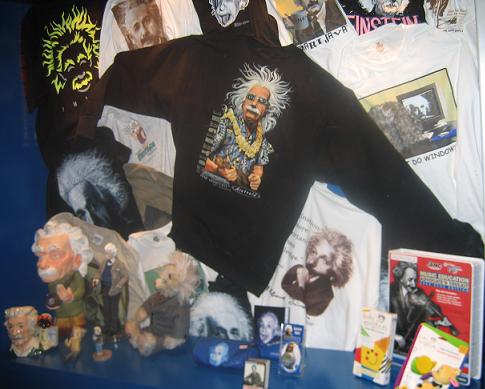Avi Blizovsky

The display cabinet of Einstein's privates at the exhibition. Photo: Avi Blizovsky. The Hebrew University receives royalties for the use of his image.
Last Thursday, the Science Museum held a tour for journalists of the Einstein exhibit, which is scheduled to open today. The tour was led by the academic responsible for the exhibition, Prof. Hanoch Gutfreund from the Hebrew University.
From time to time there are rumors that Einstein was a bad student. Perhaps the source of the rumors is that the maximum score at the school in Switzerland he attended was a six. He received this grade in all scientific subjects. Yes, he also had some fours and fives, and even one three. This low score was in the French tests. It was in 1900. When he came on his only visit to Israel, in 1925, he gave his famous speech at the British Police School on Mount Scopus (the university had not yet opened) in French.
Einstein's matriculation certificate, a Nobel Prize medal and many other items and fragments of original letters are just some of the interesting exhibits in the exhibition in honor of the centenary of Einstein's miracle year, which was displayed until now at the Museum of Nature in New York, and has now arrived at its home - Jerusalem. To wit, Einstein bequeathed his entire archive to the Hebrew University, as well as the right to use his likeness. He did not leave one thing - the manuscript of the article detailing the theory of general relativity from 1916. He presented this article to the unborn university during his visit in 1925.
An interesting detail that Prof. Gutfreund revealed to us is that there was a debate in the Zionist movement, whether the university to be established should be a graduate research institute (in the style of the Weizmann Institute today) or a university open to all. Einstein sided with the first opinion, and indeed the Hebrew University was first opened as a collection of research institutes and only later became a full university.
Some letters written by children to Einstein are displayed on one of the display tables. Among other things, they invited one of the children to be the navigator of a spaceship that his father is building, and which will take off to Mars and Venus, since they need a skilled and knowledgeable person in the field so that they do not make mistakes along the way.
The first part of the exhibition deals with his life - both private and public - including the chapter that was not in the exhibition in New York about the visit to Israel. The second part deals with his theoretical illustrations through various interactive audio-visual means.
Excerpts from the opening page of the exhibition on the Science Museum website
Look deep, deep into nature, and then you will better understand everything." - Albert Einstein
He was daring, wild in his genius, passionate in his curiosity. He saw a ray of light and imagined himself riding on it; He raised his eyes to the sky and saw in his vision a curved space-time. Albert Einstein re-explained how nature works, the essence of light, time, energy and gravity. The insights he reached fundamentally changed the way we look at the universe - and made him the most famous scientist of the 20th century.
We know Einstein the visionary physicist, but he was also a passionate humanist and active in the fight against war. He was a German-born Jew who saw himself as a true citizen of the world. His prestigious status allowed him to speak publicly on world issues from pacifism to racism, from anti-Semitism to nuclear disarmament. "My life is a simple matter of no interest to anyone," he once claimed. But in fact, his letters, notebooks and manuscripts tell a completely different story.
Einstein saw the universe as an enigma, and enjoyed trying to decipher its answers. All he needed to conceive the cosmos was his most valuable scientific work tool - the imagination.
Einstein's vision:
In Einstein's universe, gravity is not a force,
Space has valleys and hills
And second, it is not always second.
You are invited to observe the universe through Einstein's eyes.
You may be surprised by what you see!
The Einstein exhibition:
700 square meters of memorabilia, documents, active exhibits, a graphic display and films about the great man of our time. A unique exhibition about the cultural icon, the man whose image is emblazoned on beer mugs, shirts, ties and socks (although he never wore socks...). A comprehensive exhibition about the man who received hundreds of children's letters and answered them all. An exhibition that tries to explain to each of us how great the man is and what his greatest contribution to the world is. An exhibition where everyone will find their own Einstein.
Academic responsibility for the exhibition: Prof. Hanoch Gutfreund, The Hebrew University.
The exhibition is the result of a collaboration between the Museum of Natural History in New York, the Hebrew University in Jerusalem and the Bloomfield Science Museum in Jerusalem. With the support of the Foundation for Jerusalem and its donations, the Israeli Ministry of Science, Teva and Intel. Opening: Sunday 30.10.05. Starting from Monday 31.10.05 - the exhibition will be open to the general public.
For the virtual exhibition on the website of the Science Museum in Jerusalem
Einstein knew
https://www.hayadan.org.il/BuildaGate4/general2/data_card.php?Cat=~~~306086871~~~94&SiteName=hayadan
